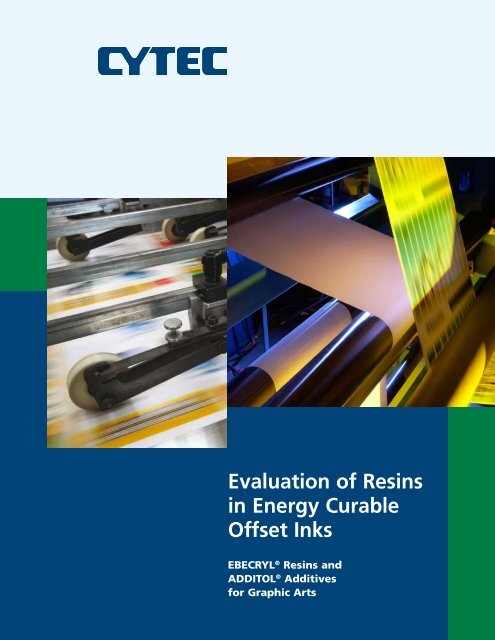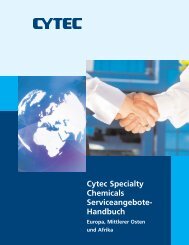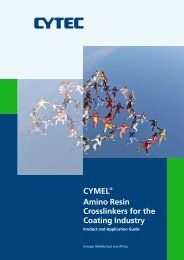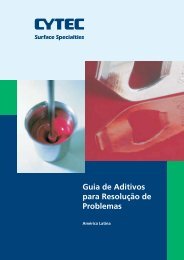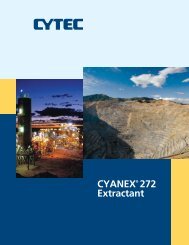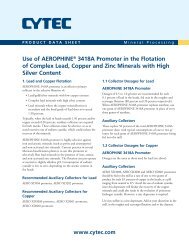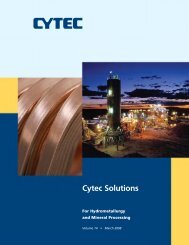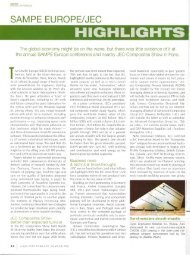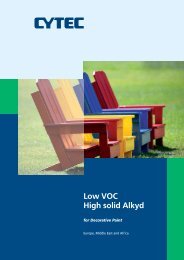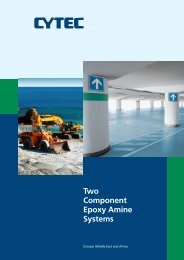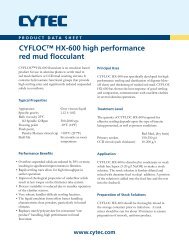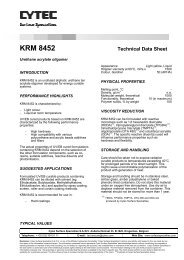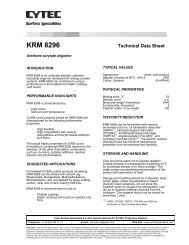Evaluation of Resins in Energy Curable Offset Inks - CYTEC Industries
Evaluation of Resins in Energy Curable Offset Inks - CYTEC Industries
Evaluation of Resins in Energy Curable Offset Inks - CYTEC Industries
You also want an ePaper? Increase the reach of your titles
YUMPU automatically turns print PDFs into web optimized ePapers that Google loves.
<strong>Evaluation</strong> <strong>of</strong> <strong>Res<strong>in</strong>s</strong><br />
<strong>in</strong> <strong>Energy</strong> <strong>Curable</strong><br />
<strong>Offset</strong> <strong>Inks</strong><br />
EBECRYL ® <strong>Res<strong>in</strong>s</strong> and<br />
ADDITOL ® Additives<br />
for Graphic Arts
About Us<br />
From def<strong>in</strong><strong>in</strong>g more efficient processes for m<strong>in</strong><strong>in</strong>g<br />
customers to develop<strong>in</strong>g new additives for polymerbased<br />
alternatives to wood and metals, the product<br />
l<strong>in</strong>es <strong>of</strong> Cytec Specialty Chemicals are unified <strong>in</strong><br />
their dedication to customer-driven <strong>in</strong>novation.<br />
Work<strong>in</strong>g closely with our customers, we develop<br />
revolutionary technologies that enable them to improve<br />
performance and productivity, enter new markets,<br />
and ref<strong>in</strong>e new applications. How to improve m<strong>in</strong>e<br />
pr<strong>of</strong>itability or coat<strong>in</strong>gs efficiency <strong>in</strong> the face <strong>of</strong><br />
important environmental concerns? How to develop<br />
polymers that really stand up to UV light? How to use<br />
phosph<strong>in</strong>es to create better, safer biocides and fumigants<br />
for agriculture? Our technology and sales teams work<br />
on-site with customers every day to address today’s<br />
bus<strong>in</strong>ess challenges and troubleshoot tomorrow’s.<br />
The applications are diverse, but the commitment<br />
is uniform: f<strong>in</strong>d<strong>in</strong>g better solutions for customers<br />
through cont<strong>in</strong>ual research, ongo<strong>in</strong>g collaboration<br />
and a passion for <strong>in</strong>novation.<br />
An Expansive Portfolio<br />
Cytec Specialty Chemicals is a complete solution<br />
provider for customers requir<strong>in</strong>g high-value surface<br />
technologies <strong>in</strong> <strong>in</strong>dustries that <strong>in</strong>clude <strong>in</strong>dustrial<br />
coat<strong>in</strong>gs, automotive, architectural, wood and paper,<br />
graphics, adhesives and opto-electronics.<br />
We <strong>of</strong>fer out customers advanced and diverse<br />
products and technologies for surfaces with an<br />
emphasis on environmentally friendly products such<br />
as UV/EB curable res<strong>in</strong>s and additives, powder<br />
coat<strong>in</strong>g res<strong>in</strong>s and additives, as well as waterborne<br />
and solventborne liquid coat<strong>in</strong>g res<strong>in</strong>s and additives.<br />
We are committed to work<strong>in</strong>g with our customers<br />
to develop environmentally advanced solutions and<br />
we are dedicated to open communication concern<strong>in</strong>g<br />
the safe handl<strong>in</strong>g, distribution, use and disposal <strong>of</strong><br />
the products we make.<br />
A Focus on Customer Satisfaction<br />
Cytec Specialty Chemicals operates a globally<br />
<strong>in</strong>tegrated set <strong>of</strong> order fulfillment IT systems and<br />
processes. All Spec Chem personnel <strong>in</strong> the order<br />
fulfillment processes are dedicated to deliver<strong>in</strong>g<br />
customer satisfaction through reliable and costeffective<br />
supply <strong>of</strong> products to our customers. Cytec<br />
Specialty Chemicals has specialized personnel <strong>in</strong><br />
Customer Service, Procurement, Manufactur<strong>in</strong>g,<br />
Plann<strong>in</strong>g and Logistics to achieve this goal. In<br />
addition to timely and accurate order fulfillment,<br />
there is an equally important focus on ma<strong>in</strong>ta<strong>in</strong><strong>in</strong>g<br />
safety and protect<strong>in</strong>g the environment at all steps <strong>in</strong><br />
the process, from the procurement <strong>of</strong> raw materials to<br />
the delivery <strong>of</strong> f<strong>in</strong>ished goods to the customer’s door.<br />
Dedication to Operational Excellence<br />
Cytec’s Spec Chem Manufactur<strong>in</strong>g Organization<br />
operates globally to provide superior service to our<br />
customers <strong>in</strong> all regions. Our vision <strong>of</strong> operational<br />
excellence br<strong>in</strong>gs value to our customers through on-<br />
go<strong>in</strong>g, cont<strong>in</strong>uous improvement <strong>in</strong>itiatives, <strong>in</strong>clud<strong>in</strong>g<br />
Lean Manufactur<strong>in</strong>g, Six Sigma Pr<strong>in</strong>ciples, and Best<br />
Practice Eng<strong>in</strong>eer<strong>in</strong>g. Our value proposition is driven<br />
by excellence <strong>in</strong> our Safety, Environmental, Quality<br />
Systems and Employee Development Programs. We<br />
are structured by bus<strong>in</strong>ess technology, which enables<br />
our sites to work transparently with R&D, Customer<br />
Service and the Bus<strong>in</strong>ess, to share best practices across<br />
common processes. We also are able to ga<strong>in</strong> leverage<br />
from overall global manufactur<strong>in</strong>g synergies to most<br />
efficiently meet customer needs.<br />
Key Product L<strong>in</strong>es<br />
■ Liquid Coat<strong>in</strong>g <strong>Res<strong>in</strong>s</strong> and Additives<br />
■ M<strong>in</strong><strong>in</strong>g Chemicals<br />
■ Phosph<strong>in</strong>e and Phosphorus Specialties<br />
■ Polymer Additives<br />
■ Powder Coat<strong>in</strong>g <strong>Res<strong>in</strong>s</strong> and Additives<br />
■ RADCURE® UV/EB<br />
■ Specialty Additives
Provider <strong>of</strong> Innovative Solutions<br />
to the Graphics Industry<br />
We are committed to consolidat<strong>in</strong>g our<br />
leadership position as the preferred sup plier<br />
to the global energy-curable graphics <strong>in</strong>dustry.<br />
We shall cont<strong>in</strong>ue to deliver added value to our<br />
customers through <strong>in</strong>novative market-driven<br />
solutions based on technological and<br />
operational excellence.<br />
To fulfill our objective <strong>of</strong> deliver<strong>in</strong>g superior<br />
value to our customers, we have a dedi cated<br />
technical service team <strong>in</strong>vestigat<strong>in</strong>g <strong>in</strong>ks and<br />
varnishes requirements for all pr<strong>in</strong>t<strong>in</strong>g processes.<br />
Based on this, we have designed a full range <strong>of</strong><br />
UV/EB vehicles, b<strong>in</strong>ders and res<strong>in</strong>s that address<br />
the most str<strong>in</strong>gent needs <strong>of</strong> the energy-cur<strong>in</strong>g<br />
graphics market.<br />
With numerous plants, research and tech nical<br />
service centers around the world, we are <strong>in</strong> a<br />
strong position to satisfy the multidimensional<br />
requirements <strong>of</strong> our customers with unrivalled<br />
world-class levels <strong>of</strong> service.<br />
Cytec Specialty Chemicals
Table <strong>of</strong> Contents<br />
Introduction to <strong>Energy</strong> <strong>Curable</strong> <strong>Offset</strong><br />
General Pr<strong>in</strong>ciples <strong>of</strong> the Lithographic Process . . . . . . . . . . . . . . . . . . . . . . 1<br />
Types <strong>of</strong> <strong>Offset</strong> Lithographic <strong>Inks</strong> . . . . . . . . . . . . . . . . . . . . . . . . . . . . . . . . . 3<br />
Typical Properties <strong>of</strong> <strong>Energy</strong> <strong>Curable</strong> <strong>Offset</strong> <strong>Inks</strong> . . . . . . . . . . . . . . . . . . . . 3<br />
<strong>Offset</strong> Ink Parameters and Test Methods . . . . . . . . . . . . . . . . . . . . . . . . . . 3<br />
Products for <strong>Energy</strong> <strong>Curable</strong> <strong>Offset</strong> <strong>Inks</strong><br />
Raw Materials Recommended for <strong>Energy</strong> <strong>Curable</strong> <strong>Offset</strong> <strong>Inks</strong> . . . . . . . . . 8<br />
General Properties <strong>of</strong> Raw Materials for <strong>Energy</strong> <strong>Curable</strong> <strong>Offset</strong> <strong>Inks</strong> . . . 13<br />
Standard Ink Formulations<br />
for <strong>Evaluation</strong>s <strong>of</strong> B<strong>in</strong>ders for <strong>Energy</strong> <strong>Curable</strong> <strong>Offset</strong> <strong>Inks</strong><br />
For Paper and Board . . . . . . . . . . . . . . . . . . . . . . . . . . . . . . . . . . . . . . . . . . 14<br />
For Non-Porous Stock . . . . . . . . . . . . . . . . . . . . . . . . . . . . . . . . . . . . . . . . . 14
Introduction to <strong>Energy</strong> <strong>Curable</strong> <strong>Offset</strong><br />
General Pr<strong>in</strong>ciples<br />
<strong>of</strong> the Lithographic Process<br />
Lithography is a planographic process, <strong>in</strong><br />
that the <strong>in</strong>k-carry<strong>in</strong>g image is <strong>in</strong> the same plane<br />
as the non-image areas. On the plate, areas <strong>of</strong><br />
different surface energy are created by chemical<br />
treatment. This process leads to the formation<br />
<strong>of</strong> image areas that are <strong>in</strong>k accept<strong>in</strong>g and water<br />
repellent, and non-image areas that are water<br />
accept<strong>in</strong>g.<br />
Usually, the plate is damped before it is <strong>in</strong>ked.<br />
The founta<strong>in</strong> solution - consist<strong>in</strong>g <strong>of</strong> water,<br />
buffer salts, surface active agents, and other<br />
additives and possibly isopropanol – forms a<br />
film on the non-image areas (water accept<strong>in</strong>g),<br />
but contracts <strong>in</strong>to t<strong>in</strong>y droplets on the image<br />
areas (water-repellent). (See Fig.1).<br />
Water Ink Ink Water<br />
α α<br />
IMAGE NON-IMAGE<br />
Ink<br />
Fig. 1: Lithographic pr<strong>in</strong>ciple.<br />
Water<br />
IMAGE NON-IMAGE<br />
When an <strong>in</strong>ked roller passes over the damped<br />
plate, the water film on the non-image areas<br />
prevents these be<strong>in</strong>g <strong>in</strong>ked up and pushes the<br />
<strong>in</strong>k towards the image areas. The water droplets<br />
present on the image areas are either removed or<br />
emulsified <strong>in</strong>to the <strong>in</strong>k. If the <strong>in</strong>k is too water<br />
repellent and this emulsification does not take<br />
place, an uneven “mottled” pr<strong>in</strong>t will result.<br />
Emulsifcation <strong>of</strong> too much water <strong>in</strong> the <strong>in</strong>k<br />
may lead to a loss <strong>of</strong> transfer and hence a loss<br />
<strong>of</strong> optical density <strong>of</strong> the pr<strong>in</strong>t.<br />
A proper “water w<strong>in</strong>dow” is necessary to be<br />
able to pr<strong>in</strong>t with vary<strong>in</strong>g levels <strong>of</strong> founta<strong>in</strong><br />
solution emulsified. It is important that when<br />
water is emulsified <strong>in</strong> the <strong>in</strong>k, the <strong>in</strong>k rheology<br />
undergoes a m<strong>in</strong>or change. This is necessary to<br />
obta<strong>in</strong> a constant <strong>in</strong>k transfer and thus stable<br />
press behavior.<br />
To pr<strong>in</strong>t correctly <strong>in</strong> lithography, the right<br />
balance between <strong>in</strong>k and founta<strong>in</strong> solution<br />
must be achieved, thus comes the term “<strong>in</strong>k<br />
water balance”.<br />
1
2<br />
Introduction to <strong>Energy</strong> <strong>Curable</strong> <strong>Offset</strong><br />
Plate<br />
cyl<strong>in</strong>der<br />
Blanket<br />
cyl<strong>in</strong>der<br />
Ink duct<br />
Impression<br />
cyl<strong>in</strong>der<br />
Fig. 2: <strong>Offset</strong> Lithographic Process.<br />
1<br />
2<br />
3<br />
Damp<strong>in</strong>g<br />
rollers<br />
Fount<br />
solution<br />
Feed<br />
substrate<br />
The process is called <strong>of</strong>fset lithography (see Fig. 2)<br />
because the <strong>in</strong>k is not transferred directly from<br />
the plate to the substrate, but is first “<strong>of</strong>fset”<br />
onto a rubber blanket cyl<strong>in</strong>der and is then<br />
transferred to the substrate.<br />
The <strong>of</strong>fset lithographic process dom<strong>in</strong>ates the<br />
graphic <strong>in</strong>dustry <strong>in</strong> a wide range <strong>of</strong> formats:<br />
from multiple color 8½" x 11" (Sheet-fed<br />
pr<strong>in</strong>t<strong>in</strong>g, see Fig. 3), to pr<strong>in</strong>t<strong>in</strong>g magaz<strong>in</strong>es and<br />
newspapers on a cont<strong>in</strong>uous web <strong>of</strong> paper<br />
(web <strong>of</strong>fset). This process is particularly suited<br />
to the production <strong>of</strong> lightweight packag<strong>in</strong>g,<br />
books, magaz<strong>in</strong>es, newspapers, brochures, maps,<br />
promotional posters and literature, bus<strong>in</strong>ess<br />
stationery, to name some examples.<br />
Fig. 3: Schematic presentation<br />
<strong>of</strong> a Sheet-fed <strong>Offset</strong> pr<strong>in</strong>t<strong>in</strong>g mach<strong>in</strong>e.
Types <strong>of</strong> <strong>Offset</strong> Lithographic <strong>Inks</strong>:<br />
<strong>Offset</strong> lithographic <strong>in</strong>ks are <strong>of</strong>ten characterised<br />
accord<strong>in</strong>g their dry<strong>in</strong>g method:<br />
• Absorption: cold-set <strong>in</strong>ks (eg. newspaper<br />
<strong>in</strong>ks)<br />
• Evaporation: heat-set <strong>in</strong>ks<br />
• Oxidation: conventional sheet-fed <strong>in</strong>ks<br />
• <strong>Energy</strong> cur<strong>in</strong>g (UV/EB)<br />
<strong>Energy</strong> <strong>Curable</strong> <strong>Offset</strong> <strong>in</strong>ks are used <strong>in</strong> sheet-fed<br />
and web-fed applications. The sett<strong>in</strong>g and the<br />
dry<strong>in</strong>g <strong>of</strong> the <strong>in</strong>k occur <strong>in</strong> approximately 0,1 s.<br />
by transform<strong>in</strong>g the wet b<strong>in</strong>der <strong>in</strong>to an <strong>in</strong>soluble<br />
dry <strong>in</strong>k film through a polymerisation reaction.<br />
The polymerisation is <strong>in</strong>duced by UV light (or<br />
electron beam).<br />
<strong>Energy</strong> curable <strong>in</strong>ks ma<strong>in</strong>ly consist <strong>of</strong>:<br />
• Acrylated res<strong>in</strong>s (oligomers):<br />
basic coat<strong>in</strong>g properties<br />
• Monomers (di- to hexa acrylates): viscosity<br />
reduction, flexibility (mon<strong>of</strong>unctional);<br />
crossl<strong>in</strong>k<strong>in</strong>g (multifunctional<br />
• Pigments and fillers<br />
• Additives: performance f<strong>in</strong>e tun<strong>in</strong>g<br />
• Photo<strong>in</strong>itiator package: free radical<br />
generation to <strong>in</strong>itiate polymerisation<br />
Typical Properties <strong>of</strong> <strong>Energy</strong> <strong>Curable</strong><br />
<strong>Offset</strong> <strong>Inks</strong>:<br />
• Immediate dry<strong>in</strong>g (surface and <strong>in</strong>-depth)<br />
• On-l<strong>in</strong>e process<strong>in</strong>g<br />
• No spray powder needed <strong>in</strong> sheet-fed <strong>of</strong>fset<br />
• Increased productivity<br />
• No solvents used<br />
• No dry<strong>in</strong>g <strong>of</strong> <strong>in</strong>k on the pr<strong>in</strong>t<strong>in</strong>g press<br />
(less clean<strong>in</strong>g)<br />
• Low energy level required (vs heat dry<strong>in</strong>g)<br />
• Ability to pr<strong>in</strong>t on a wide variety <strong>of</strong><br />
substrates with the same <strong>in</strong>k<br />
• Pr<strong>in</strong>t<strong>in</strong>g on heat-sensitive substrates<br />
• Reduced space required (vs heat dry<strong>in</strong>g)<br />
• High gloss<br />
• High chemical resistance<br />
<strong>Offset</strong> Ink Parameters<br />
and Test Methods<br />
Ink Parameters<br />
<strong>Inks</strong> used for the lithographic <strong>in</strong>dustry must<br />
fulfil a number <strong>of</strong> requirements:<br />
• Suitable Viscosity (expressed <strong>in</strong> Pa.s or poise)<br />
• Low tack (at 1200 RPM, 90° F)<br />
• Low mist<strong>in</strong>g<br />
• Good <strong>in</strong>k-water balance<br />
• Good reactivity<br />
Dur<strong>in</strong>g the last decades, a number <strong>of</strong> methods<br />
have been developed to evaluate properties<br />
<strong>of</strong> wet <strong>in</strong>ks and pr<strong>in</strong>ted (dried) <strong>in</strong>ks. We have<br />
chosen the follow<strong>in</strong>g laboratory methods to<br />
assess the above characteristics.<br />
3
4 Introduction to <strong>Energy</strong> <strong>Curable</strong> <strong>Offset</strong><br />
Lithographic <strong>Inks</strong> <strong>Evaluation</strong> Capabilities at Cytec Specialty Chemicals, Americas<br />
Oligomer Viscosity<br />
■ Def<strong>in</strong>ition:<br />
Viscosity is def<strong>in</strong>ed as a fluid’s resistance<br />
to flow. There are a number <strong>of</strong> available<br />
<strong>in</strong>struments and methods to measure<br />
viscosity.<br />
■ Equipment:<br />
• Brookfield Rotational Viscometer,<br />
Model RVDV<br />
• Brookfield Thermosel Chamber or Small<br />
Cell Adapter<br />
• Electronic Temperature controller or<br />
programmable circulat<strong>in</strong>g water bath<br />
• Brookfield Sample Conta<strong>in</strong>er<br />
• Brookfield Sp<strong>in</strong>dles<br />
■ Material:<br />
• Oligomer sample<br />
■ Test<strong>in</strong>g Method:<br />
• Appropriate oligomer sample size is added<br />
to Brookfield sample conta<strong>in</strong>er<br />
• Select RPM and sp<strong>in</strong>dle number by<br />
select<strong>in</strong>g the appropriate button on the<br />
viscometer keypad<br />
• Measure and record viscosity<br />
Tack<br />
■ Def<strong>in</strong>ition:<br />
Tack is a relative measurement <strong>of</strong> the<br />
cohesion or stick<strong>in</strong>ess <strong>of</strong> an <strong>in</strong>k film. Tack<br />
is measured by measur<strong>in</strong>g the force required<br />
to split an <strong>in</strong>k film between two rollers. The<br />
tackier the <strong>in</strong>k, the higher the force required<br />
for film separation. Tack is recorded <strong>in</strong><br />
arbitrary units, depend<strong>in</strong>g on <strong>in</strong>strument<br />
used for measurement.<br />
■ Equipment:<br />
• Thw<strong>in</strong>g-Albert Electronic Inkometer<br />
(See Fig. 4)<br />
■ Material:<br />
• 0.2 cc <strong>in</strong>k<br />
■ Test<strong>in</strong>g Method:<br />
• Ink is applied to bottom vibrator<br />
roller and manually spread onto the<br />
other rollers<br />
• Initiate test<strong>in</strong>g at 1200 RPM, 90° F<br />
• Ink tack is recorded after 1 m<strong>in</strong>ute<br />
Fig. 4: Thw<strong>in</strong>g-Albert Electronic Inkometer.
Lithographic <strong>Inks</strong> <strong>Evaluation</strong> Capabilities at Cytec Specialty Chemicals, Americas<br />
Mist<strong>in</strong>g<br />
■ Def<strong>in</strong>ition:<br />
Ink mist<strong>in</strong>g is the f<strong>in</strong>e mist or spray <strong>of</strong> <strong>in</strong>k<br />
thrown <strong>of</strong>f rapidly mov<strong>in</strong>g rollers (See Fig. 5).<br />
■ Equipment:<br />
• Thw<strong>in</strong>g-Albert Electronic Inkometer<br />
• Spectrodensitometer<br />
■ Materials (<strong>in</strong>k mist<strong>in</strong>g is usually measured<br />
at the same time as <strong>in</strong>k tack):<br />
• 0.2 cc <strong>in</strong>k<br />
• Coated white paper (trimmed to fit <strong>in</strong>to<br />
bottom <strong>in</strong>kometer tray)<br />
■ Test<strong>in</strong>g Method:<br />
• A piece <strong>of</strong> coated white paper is placed<br />
<strong>in</strong> the tray beneath the bottom<br />
<strong>in</strong>kometer roller<br />
• Beg<strong>in</strong> test<strong>in</strong>g at 1200 RPM, 90° F, 1 m<strong>in</strong>.<br />
• After complet<strong>in</strong>g the tack test<strong>in</strong>g, the<br />
paper is removed and the <strong>in</strong>k area is<br />
divided <strong>in</strong>to quadrants (See Fig. 6)<br />
• In each quadrant, the total color<br />
difference (∆E) between unexposed paper<br />
and the test specimen is measured<br />
• The average <strong>of</strong> the four read<strong>in</strong>gs is reported.<br />
– Note: This is not an absolute value<br />
but <strong>in</strong>dicates an <strong>in</strong>k’s tendency to<br />
exhibit mist<strong>in</strong>g<br />
Roller<br />
Roller<br />
Fig. 5: Ink film splitt<strong>in</strong>g.<br />
Cavity<br />
formation<br />
Str<strong>in</strong>g<br />
formation<br />
Fig. 6: Example <strong>of</strong> mist<strong>in</strong>g result.<br />
Reactivity (Cure Speed)<br />
■ Def<strong>in</strong>ition:<br />
Reactivity is the speed or rate <strong>of</strong><br />
polymerization <strong>of</strong> an energy curable <strong>in</strong>k.<br />
Technically, reactivity is the energy density<br />
required to dry, cur<strong>in</strong>g or polymerize the <strong>in</strong>k<br />
film. Reactivity is reported as energy density<br />
and expressed as J/cm 2 or mJ/cm 2 .<br />
■ Equipment:<br />
• Aetek UV Cur<strong>in</strong>g System<br />
– 1-400 watts/<strong>in</strong>. UV lamp<br />
• Radiometer (light bug)<br />
• “Little Joe” Pro<strong>of</strong><strong>in</strong>g System with<br />
wedge plate<br />
■ Materials:<br />
• Coated white paper<br />
• Ink<br />
5
6 Introduction to <strong>Energy</strong> <strong>Curable</strong> <strong>Offset</strong><br />
Lithographic <strong>Inks</strong> <strong>Evaluation</strong> Capabilities at Cytec Specialty Chemicals, Americas<br />
■ Test<strong>in</strong>g Method:<br />
• Ink is applied to coated paper at<br />
appropriate film thickness us<strong>in</strong>g “Little<br />
Joe” pro<strong>of</strong>er and exposed to cur<strong>in</strong>g source<br />
• After exposure, the <strong>in</strong>k surface is<br />
vigorously rubbed with the <strong>in</strong>dex f<strong>in</strong>ger<br />
– If no <strong>in</strong>k removed, the <strong>in</strong>k is cured<br />
at this exposure. Us<strong>in</strong>g a radiometer,<br />
the energy density is measured<br />
and recorded. Also recorded is the<br />
conveyor/belt speed<br />
– The conveyor/belt speed is <strong>in</strong>creased the<br />
test is repeated until <strong>in</strong>k is removed<br />
– If <strong>in</strong> the <strong>in</strong>itial test<strong>in</strong>g, <strong>in</strong>k is rubbed<br />
<strong>of</strong>f, the conveyor/belt speed is decreased<br />
and the test repeated until <strong>in</strong>k is not<br />
removed by rubb<strong>in</strong>g the surface<br />
– The shortest exposure (lowest energy<br />
density) needed to achieve no <strong>in</strong>k<br />
removal is reported as the <strong>in</strong>k reactivity<br />
Adhesion to Non Porous Substrates<br />
■ Def<strong>in</strong>ition:<br />
Adhesion is ability <strong>of</strong> an <strong>in</strong>k to bond<br />
completely with the substrate. When there<br />
is full adhesion the <strong>in</strong>k is not removed<br />
<strong>in</strong> standard tape test<strong>in</strong>g. There are two<br />
methods used for tape test adhesion test<strong>in</strong>g –<br />
tape pull on filmic substrates and cross hatch<br />
on rigid substrates. Adhesion is typically<br />
expressed as percent <strong>of</strong> <strong>in</strong>k adher<strong>in</strong>g or<br />
rema<strong>in</strong><strong>in</strong>g on the substrate.<br />
■ Equipment:<br />
• Aetek UV Cur<strong>in</strong>g System<br />
– 1-400 watts/<strong>in</strong>. UV lamp<br />
• “Little Joe” Pro<strong>of</strong><strong>in</strong>g System with<br />
wedge plate<br />
• Specified test tape (usually 3M’s 600 or<br />
610 tape)<br />
• Cross hatch tool<br />
■ Materials:<br />
• Specified non-porous substrate<br />
– Coated<br />
– Uncoated<br />
• Ink<br />
■ Test<strong>in</strong>g Method:<br />
• Ink is applied to substrate at appropriate<br />
film thickness us<strong>in</strong>g “Little Joe” pro<strong>of</strong>er<br />
and then cured with appropriate energy<br />
density<br />
• After cur<strong>in</strong>g, a strip <strong>of</strong> test tape is applied<br />
to the <strong>in</strong>k surface<br />
– If test<strong>in</strong>g adhesion to a rigid substrate, a<br />
cross hatch tool is used to score the <strong>in</strong>k<br />
film prior to apply<strong>in</strong>g the tape<br />
• At a 60° angle, the tape is quickly ripped<br />
from the <strong>in</strong>k surface<br />
• The percent <strong>in</strong>k rema<strong>in</strong><strong>in</strong>g on the<br />
substrate is determ<strong>in</strong>ed and reported
Pr<strong>in</strong>tability<br />
■ Def<strong>in</strong>ition:<br />
Pr<strong>in</strong>tability is the <strong>in</strong>k’s behavior <strong>in</strong> a<br />
lithographic pr<strong>in</strong>t<strong>in</strong>g environment.<br />
This test<strong>in</strong>g simulates the handl<strong>in</strong>g and<br />
application <strong>of</strong> an <strong>in</strong>k at a pr<strong>in</strong>ter’s facility.<br />
The test<strong>in</strong>g evaluates <strong>in</strong>k transfer, <strong>in</strong>k-water<br />
balance, image quality and productivity.<br />
■ Equipment:<br />
• Ryobi CD 2800 Duplicator outfitted<br />
with <strong>in</strong>tegrated dampen<strong>in</strong>g system and<br />
UV cur<strong>in</strong>g system (See Fig. 7)<br />
■ Materials:<br />
• 70# coated paper<br />
• Founta<strong>in</strong> solution<br />
• Ink<br />
■ Test<strong>in</strong>g Method:<br />
• Ink is pr<strong>in</strong>ted <strong>in</strong> accordance with <strong>in</strong>dustry<br />
procedures<br />
• Dur<strong>in</strong>g pr<strong>in</strong>t<strong>in</strong>g, <strong>in</strong>k is evaluated for ease<br />
<strong>of</strong> establish<strong>in</strong>g and ma<strong>in</strong>ta<strong>in</strong><strong>in</strong>g color<br />
density and pr<strong>in</strong>t contrast<br />
• Also evaluated are press make ready and<br />
clean up<br />
Fig. 7: Ryobi CD 2800 Duplicator.<br />
7
8<br />
Products for <strong>Energy</strong> <strong>Curable</strong><br />
Lithographic <strong>Inks</strong><br />
This section describes products recommended<br />
for energy curable <strong>of</strong>fset <strong>in</strong>ks. General<br />
recommendations are given on the use <strong>of</strong> the<br />
different types <strong>of</strong> acrylates <strong>in</strong> energy curable<br />
<strong>of</strong>fset <strong>in</strong>ks. Features and benefits <strong>of</strong> each<br />
product are also mentioned.<br />
General Recommendations<br />
Product Type Benefits<br />
Polyester acrylates Pigment wett<strong>in</strong>g<br />
Ink water balance<br />
Diluted polyesters Adhesion to plastics<br />
and metals<br />
Epoxy acrylates Reactivity<br />
Hardness; scratch resistance<br />
Solvent resistancy<br />
Modified epoxy<br />
acrylates<br />
Improved <strong>in</strong>k water balance<br />
Urethane acrylates Reactivity (dark colors)<br />
Hardness; scratch resistance<br />
Solvent resistancy<br />
Dilut<strong>in</strong>g acrylates Viscosity/tack adjustment
Polyester Acrylates<br />
Products<br />
Functionality,<br />
Theoretical<br />
EBECRYL ® 657 Tetrafunctional 103500<br />
EBECRYL 811 Trifunctional 90000<br />
EBECRYL 838 Hexafunctional 49298<br />
EBECRYL 846 Tetrafunctional 45000<br />
EBECRYL 870 Hexafunctional 43070<br />
EBECRYL 871 Hexafunctional 47450<br />
EBECRYL 889 Tetrafunctional 32300<br />
EBECRYL 1657 Tetrafunctional 124800<br />
Diluted Polyesters<br />
Products Description<br />
EBECRYL 436<br />
EBECRYL 438<br />
EBECRYL 586<br />
Chlor<strong>in</strong>ated polyester<br />
<strong>in</strong> 40% TMPTA<br />
Chlor<strong>in</strong>ated polyester<br />
<strong>in</strong> 40% OTA 480<br />
Chlor<strong>in</strong>ated polyester<br />
<strong>in</strong> 40% TMPTA<br />
Oligomers and Monomers for<br />
Lithographic <strong>Inks</strong><br />
Viscosity,<br />
cP @ 25°C Key Features and Benefits<br />
•<br />
•<br />
•<br />
•<br />
•<br />
•<br />
•<br />
•<br />
•<br />
•<br />
•<br />
•<br />
•<br />
•<br />
•<br />
•<br />
Good pigment wett<strong>in</strong>g, especially yellow pigments<br />
Provides <strong>in</strong>k with higher <strong>in</strong>k tacks<br />
Very low <strong>in</strong>k mist<strong>in</strong>g<br />
Provides very good <strong>in</strong>k-water balance<br />
Good surface hardness<br />
Good chemical resistance<br />
Good reactivity<br />
Suitable for paper and board on web presses<br />
Excellent pigment wett<strong>in</strong>g<br />
Good overall lithographic properties<br />
Excellent pigment wett<strong>in</strong>g<br />
Provides <strong>in</strong>k with lower <strong>in</strong>k tacks<br />
Good adhesion to super-calendared paper<br />
Good pr<strong>in</strong>tability to super-calendared paper<br />
Purified version <strong>of</strong> EBECRYL 657<br />
Low residual odor<br />
Viscosity,<br />
cP @ 25°C Key Features and Benefits<br />
100000<br />
85600<br />
45029<br />
•<br />
•<br />
•<br />
•<br />
•<br />
•<br />
Good adhesion to non–porous substrates<br />
Good adhesion to metals<br />
Good adhesion to non–porous substrates<br />
Good adhesion to metals<br />
Good adhesion to non–porous substrates<br />
Good flexibility<br />
9
10<br />
Products for <strong>Energy</strong> <strong>Curable</strong><br />
Lithographic <strong>Inks</strong> (cont<strong>in</strong>ued)<br />
Epoxy Acrylates<br />
Products Description<br />
EBECRYL 860<br />
EBECRYL 3411<br />
EBECRYL 3701<br />
EBECRYL 3702<br />
EBECRYL 3708<br />
Epoxidized Soya Oil<br />
Tetra-Acrylate<br />
Fatty Acid Modified<br />
Epoxy Diacrylate<br />
Modified Bisphenol A<br />
Epoxy Diacrylate<br />
Fatty Acid Modified<br />
Epoxy Diacrylate<br />
Modified Bisphenol A<br />
Epoxy Acrylate<br />
Viscosity,<br />
cP @ 25°C Key Features and Benefits<br />
26518<br />
40100<br />
1600000<br />
495000<br />
190000<br />
EBECRYL 3720 Bisphenol A Epoxy Diacrylate 750000<br />
Urethane Acrylates (used as additives)<br />
Products Description<br />
EBECRYL 220 Aromatic Urethane Hexacrylate 28268<br />
EBECRYL 230 Aliphatic Urethane Diacrylate 44014<br />
EBECRYL 1290 Aliphatic Urethane Hexacrylate 85000<br />
EBECRYL 4827 Aromatic Urethane Diacrylate 238000<br />
•<br />
•<br />
•<br />
•<br />
•<br />
•<br />
•<br />
•<br />
•<br />
•<br />
•<br />
•<br />
Good flow and level<strong>in</strong>g<br />
Good compatibility with hybrids <strong>in</strong>ks<br />
Good pigment wett<strong>in</strong>g<br />
Good flow and level<strong>in</strong>g<br />
High reactivity<br />
Increases <strong>in</strong>k tack<br />
Increased flexibility<br />
Increases <strong>in</strong>k tack<br />
Provides flexibility<br />
Recommended for metal deco<br />
Good solvent resistance<br />
Increases <strong>in</strong>k tack<br />
Viscosity,<br />
cP @ 25°C Key Features and Benefits<br />
•<br />
•<br />
•<br />
•<br />
•<br />
•<br />
•<br />
•<br />
Enhances reactivity <strong>in</strong> dark colored <strong>in</strong>ks<br />
Enhances scratch resistance<br />
Increases flexibility<br />
Low Tg<br />
Enhances hardness<br />
Increases scratch resistance<br />
Enhances flexibility<br />
Enhances adhesion to plastics
Dilut<strong>in</strong>g Acrylates<br />
Products<br />
EBECRYL 1039<br />
EBECRYL 113<br />
TRPGDA<br />
NPG(PO) 2 DA<br />
EBECRYL 150<br />
TMPEOTA<br />
OTA 480<br />
TMPTA<br />
Description<br />
Theoretical<br />
Urethane Mon<strong>of</strong>unctional<br />
Acrylate<br />
Aliphatic Mon<strong>of</strong>unctional<br />
acrylate<br />
Tripropylene Glycol<br />
Diacrylate<br />
Neopentyl Glycol Propoxylate<br />
Diacrylate<br />
Bisphenol A Ethoxylate<br />
Diacrylate<br />
Trimethylolpropane Ethoxy<br />
Triacrylate<br />
Propoxylated Glycerol<br />
Triacrylate<br />
Trimethylolpropane<br />
Triacrylate<br />
Viscosity,<br />
cP @ 25°C Key Features and Benefits<br />
40<br />
120<br />
12 .9<br />
15 .9<br />
1347<br />
21<br />
88<br />
108<br />
EBECRYL 40 Polyether Tetra-acrylate 147<br />
EBECRYL 140<br />
Di-trimethylolpropane<br />
Tetra-acrylate<br />
979<br />
DPHA Acrylated Dipentaerythriol 17093<br />
Specialty: Bioligomers – Renewable<br />
Products Description<br />
EBECRYL 5500 Glycerol Derivative Triacrylate 110<br />
EBECRYL 5610 Modified Epoxy Acrylate 2200<br />
EBECRYL 5820 Polyester Tetra-Acrylate 66100<br />
EBECRYL 5821 Polyester Pentaacrylate 27500<br />
EBECRYL 5822 Polyester Pentaacrylate 29200<br />
•<br />
•<br />
•<br />
•<br />
•<br />
•<br />
•<br />
•<br />
•<br />
•<br />
•<br />
•<br />
•<br />
•<br />
•<br />
•<br />
•<br />
•<br />
•<br />
•<br />
•<br />
•<br />
•<br />
Enhances adhesion to non-porous substrates<br />
Good reactivity (for mon<strong>of</strong>unctional monomer)<br />
Enhances adhesion to non-porous substrates<br />
Good pigment wett<strong>in</strong>g<br />
Good reactivity (for mon<strong>of</strong>unctional monomer)<br />
Good diluent<br />
Good reactivity without brittleness<br />
Increases flexibility<br />
Lower surface tension<br />
High reactivity<br />
Enhances scratch resistance<br />
Good reactivity<br />
Increased flexibility (vs . TMPTA)<br />
Good pigment wett<strong>in</strong>g<br />
Good reactivity<br />
Increases crossl<strong>in</strong>k<strong>in</strong>g and hardness<br />
Good chemical resistance<br />
Good reactivity<br />
Good hardness without brittleness<br />
High crossl<strong>in</strong>k<strong>in</strong>g<br />
Increased hardness<br />
High reactivity<br />
Increased hardness<br />
Viscosity,<br />
cP @ 25°C Key Features and Benefits<br />
•<br />
•<br />
•<br />
•<br />
•<br />
•<br />
•<br />
•<br />
•<br />
•<br />
Partially based on renewable resources<br />
Good cure response<br />
Hardness<br />
Partially based on renewable resources<br />
Developed for OPV’s<br />
Good flow and level<strong>in</strong>g<br />
Partially based on renewable resources<br />
Good pigment wett<strong>in</strong>g<br />
Partially based on renewable resources<br />
Good reactivity<br />
• Partially based on renewable resources<br />
•<br />
Good color development with carbon blacks<br />
11
12<br />
Products for <strong>Energy</strong> <strong>Curable</strong><br />
Lithographic <strong>Inks</strong> (cont<strong>in</strong>ued)<br />
Specialty: Low Odor and Low Extractables<br />
Products Description<br />
EBECRYL LEO ® 10501 Trifunctional Dilut<strong>in</strong>g Acrylate 80<br />
EBECRYL LEO 10601 Modified Epoxy Acrylate 200000<br />
EBECRYL LEO 10801 Hexafunctional Polyester Acrylate 48000<br />
Additives<br />
Photo<strong>in</strong>itiators<br />
Miscellaneous<br />
Viscosity,<br />
cP @ 25°C Key Features and Benefits<br />
•<br />
•<br />
•<br />
•<br />
•<br />
•<br />
High reactivity<br />
Lower viscosity<br />
Good solvent resistance<br />
Good reactivity<br />
Good pigment wett<strong>in</strong>g<br />
High reactivity<br />
Products Type Key Features and Benefits<br />
ADDITOL ® BCPK Mixture<br />
ADDITOL DX Mixture<br />
ADDITOL LX Mixture<br />
ADDITOL BP H-Abstraction<br />
ADDITOL BDK α-cleavage<br />
ADDITOL CPK α-cleavage<br />
ADDITOL HDMAP α-cleavage<br />
ADDITOL ITX H-Abstraction<br />
ADDITOL TPO α-cleavage<br />
EBECRYL P39 H-Abstraction<br />
EBECRYL 350 Silicone Diacrylate<br />
EBECRYL 1360 Silicone Hexaacrylate<br />
•<br />
•<br />
•<br />
•<br />
•<br />
•<br />
•<br />
•<br />
•<br />
•<br />
•<br />
•<br />
•<br />
•<br />
•<br />
•<br />
•<br />
•<br />
•<br />
•<br />
•<br />
•<br />
Easily <strong>in</strong>corporated<br />
Good comb<strong>in</strong>ation <strong>of</strong> surface and through cure<br />
Liquid photo<strong>in</strong>itiator<br />
Effective <strong>in</strong> pigmented <strong>in</strong>ks at 5-10% levels<br />
Liquid photo<strong>in</strong>itiator<br />
Effective <strong>in</strong> white and yellow <strong>in</strong>ks at 5-10% levels<br />
Good solubility<br />
Excellent surface cure<br />
Good solubility<br />
Multipurpose photo<strong>in</strong>itiator – use alone or comb<strong>in</strong>ed<br />
with other photo<strong>in</strong>itiators<br />
Good solubility<br />
Good surface an through cure<br />
Liquid photo<strong>in</strong>itiator<br />
Good solvency <strong>of</strong> solid photo<strong>in</strong>itiators<br />
Good solubility<br />
Good through cure<br />
Low yellow<strong>in</strong>g <strong>in</strong> white pigmented <strong>in</strong>ks<br />
Good through cure<br />
Low residual odor<br />
Pourable liquid<br />
COF reduction<br />
Non-migratory<br />
• COF reduction<br />
• Non-migratory<br />
•<br />
Especially effective <strong>in</strong> EB
General Properties <strong>of</strong> Products for <strong>Energy</strong> <strong>Curable</strong> Lithographic <strong>Inks</strong> (Relative rank<strong>in</strong>g)<br />
Products Viscosity Reactivity<br />
Pigment<br />
Wett<strong>in</strong>g<br />
Ink<br />
Tack<br />
Ink<br />
Mist<strong>in</strong>g Pr<strong>in</strong>tability<br />
Adhesion to<br />
Non-porous<br />
Substrates<br />
EBECRYL 113 N/A ●●● ●●● N/A N/A N/A ●●●●<br />
EBECRYL 1039 N/A ●●● ●●● N/A N/A N/A ●●●●<br />
EBECRYL 150 N/A ●●● ●● N/A N/A N/A ●<br />
OTA 480 N/A ●●● ●●●●● N/A N/A N/A ●<br />
EBECRYL 40 N/A ●●●● ●●● N/A N/A N/A ●<br />
EBECRYL 140 N/A ●●●● ●●● N/A N/A N/A ●<br />
DPHA N/A ●●●●● N/A N/A N/A N/A ●<br />
EBECRYL 436 ●● ●● ● ●●● ●●● N/A ●●●●●<br />
EBECRYL 438 ●● ●● ● ●●● ●●● N/A ●●●●●<br />
EBECRYL 586 ●● ●● ● ●●● ●●● N/A ●●●●●<br />
EBECRYL 657 ●● ●●●●● ●●●●● ●●● ●●●● ●●●●● ●●<br />
EBECRYL 811 ●● ●●● ●●● ●●●● ●●●●● ●●●●● ●●●<br />
EBECRYL 838 ●●●●● ●●●●● ●●●● ●●● ●●● ●●●● ●<br />
EBECRYL 846 ●●●●● ●●●●● ●●●● ●●●● ●●●● ●●●● ●<br />
EBECRYL 860 ●●● ●●● ●● ●●● ●● ●● ●●<br />
EBECRYL 870 ●●●●● ●●●●● ●●●●● ●●●● ●●●● ●●●●● ●●<br />
EBECRYL 871 ●●●●● ●●●●● ●●●●● ●●●● ●●●● ●●●●● ●<br />
EBECRYL 889 ●●●● ●●●● ●●●● ●●●● ●●●● ●●●● ●<br />
EBECRYL 1657 ●● ●●●●● ●●●●● ●●●● ●●●● ●●●● ●<br />
EBECRYL 3411 ●●●● ●●● ●●●●● ●●● ●●● ●●● ●<br />
EBECRYL 3701 ● ●●● ●● ● ●●● ●● ●<br />
EBECRYL 3702 ● ●●● ●●● ● ●●● ●● ●<br />
EBECRYL 3720 ● ●●● ●● ● ●●● ●● ●<br />
EBECRYL 220 N/A ●●●●● N/A N/A N/A N/A ●<br />
EBECRYL 230 N/A ●●● N/A N/A N/A N/A ●●●<br />
EBECRYL 1290 N/A ●●●●● N/A N/A N/A N/A ●<br />
EBECRYL 4827 N/A ●●● N/A N/A N/A N/A ●●●<br />
N/A = Not Applicable<br />
Key<br />
Adhesion to Non-Porous Substrates Poor Excellent<br />
Ink Mist<strong>in</strong>g High Low<br />
Ink Tack High Low<br />
Pigment Wett<strong>in</strong>g Poor Excellent<br />
Pr<strong>in</strong>tability Poor Excellent<br />
Reactivity Low High<br />
Viscosity Higher Lower<br />
13
14<br />
Standard Ink Formulations for <strong>Evaluation</strong> <strong>of</strong><br />
Oligomers for <strong>Energy</strong> <strong>Curable</strong> Lithographic <strong>Inks</strong><br />
The formulations <strong>in</strong>dicated below have only<br />
been designed to provide us with a test method<br />
to evaluate our new development products.<br />
They are representative enough to give an<br />
<strong>in</strong>dication <strong>of</strong> the way our products perform <strong>in</strong><br />
Paper and Board Stock:<br />
Pigment Dispersion<br />
Acrylated oligomer 50-60%<br />
Polyester acrylate and/or epoxy acrylate<br />
Pigment 30-40%<br />
OTA 480 5-10%<br />
Ink<br />
Pigment dispersion 55-60%<br />
Acrylated oligomer 20-30%<br />
Polyester acrylate and/or epoxy acrylate<br />
Inert Filler 2-5%<br />
Wax 0-2%<br />
Dilut<strong>in</strong>g acrylate 2-5%<br />
TRPGDA, TMPTA or TMPEOTA<br />
Additol DX liquid photo<strong>in</strong>itiator blend 8-10%<br />
<strong>Energy</strong> <strong>Curable</strong> <strong>Offset</strong> <strong>Inks</strong>. However, they can<br />
not be considered as recommanded formulations<br />
and are not meant to deliver optimal<br />
performance <strong>in</strong> all applications.<br />
Non-Porous Stock:<br />
Pigment Dispersion<br />
Acrylated oligomer 50-60%<br />
Diluted polyester<br />
Pigment 30-40%<br />
OTA 480 5-10%<br />
Ink<br />
Pigment dispersion 55-60%<br />
Acrylated oligomer 20-30%<br />
Diluted polyester acrylate<br />
Inert Filler 2-5%<br />
Wax 0-2%<br />
Dilut<strong>in</strong>g acrylate 2-5%<br />
TRPGDA, NPG(PO)2DA, EBECRYL 1039 or EBECRYL 113<br />
Additol DX liquid photo<strong>in</strong>itiator blend 8-10%
Cytec <strong>Industries</strong> Inc.<br />
Americas<br />
Contact Us<br />
1950 Lake Park Drive<br />
Smyrna, GA 30080 USA<br />
Tel: 1 800 433 2873 (USA)<br />
Fax: 1 678 255 4746 (Outside USA)<br />
customerservicena@cytec .com<br />
Global Product Referral<br />
Tel: 1 800 652 6013 (USA)<br />
Tel: 1 973 357 3193 (Outside USA)<br />
cust<strong>in</strong>fo@cytec .com<br />
Trademark Notice: The ® <strong>in</strong>dicates a Registered Trademark <strong>in</strong> the United States and the or * <strong>in</strong>dicates a Trademark <strong>in</strong> the United States. The mark may also<br />
be registered, the subject <strong>of</strong> an application for registration, or a trademark <strong>in</strong> other countries.<br />
Notice: Cytec <strong>Industries</strong> Inc. <strong>in</strong> its own name and on behalf <strong>of</strong> its affiliated companies (collectively, “Cytec”) decl<strong>in</strong>e any liability with respect to the use made by<br />
anyone <strong>of</strong> the <strong>in</strong>formation conta<strong>in</strong>ed here<strong>in</strong>. The <strong>in</strong>formation conta<strong>in</strong>ed here<strong>in</strong> represents Cytec’s best knowledge thereon without constitut<strong>in</strong>g any express or<br />
implied guarantee or warranty <strong>of</strong> any k<strong>in</strong>d (<strong>in</strong>clud<strong>in</strong>g, but not limited to, regard<strong>in</strong>g the accuracy, the completeness or relevance <strong>of</strong> the data set out here<strong>in</strong>). Cytec<br />
is the sole owner or authorized user <strong>of</strong> the <strong>in</strong>tellectual property rights relat<strong>in</strong>g to the <strong>in</strong>formation communicated. The <strong>in</strong>formation relat<strong>in</strong>g to the use <strong>of</strong> the products<br />
is given for <strong>in</strong>formation purposes only. No guarantee or warranty is provided that the product is adapted for any specific use. The user or purchaser should perform<br />
its own tests to determ<strong>in</strong>e the suitability for a particular purpose. The f<strong>in</strong>al choice <strong>of</strong> use <strong>of</strong> a product rema<strong>in</strong>s the sole responsibility <strong>of</strong> the user.<br />
RAD-0004-A-EN-NA-12A<br />
©2010 Cytec <strong>Industries</strong> Inc . All rights reserved .<br />
Europe<br />
Erasmus Office Park<br />
Square Marie Curie 11<br />
B-1070 Brussels<br />
Belgium<br />
Tel: +32 2 560 45 11<br />
Fax: +32 2 560 45 21<br />
surfsspec@cytec .com<br />
www.cytec.com<br />
Asia Pacific/Ch<strong>in</strong>a<br />
11D Junyao International Plaza<br />
No . 789, Zhao Jia Bang Road<br />
Xuhui District, Shanghai 200032<br />
Tel: +86 21 64228920<br />
Fax: +86 21 64228980<br />
ch<strong>in</strong>a@cytec .com


